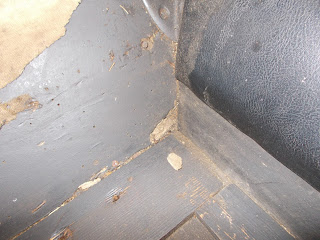Since we rarely have a Christmas tree, it would only have been for a photo op, and I decided I'd rather work on the wagon right now than go through all that bother.
But first, I had a pending project in the shop that had to be finished up. Two wheels from a different carriage were partially prepared for what was to be a thorough refinishing. The task was reduced to a good deglossing, followed by a quick but reasonably attractive rattle-can re-finish. Good for another decade!
The wagon seat comes off the box by simply popping up a couple of little latches, one of which can be seen in the lower right corner of the photo.
I have already reupholstered the cushion, which was originally done in the biscuit pattern shown. I will probably re-do the sides of the cushion, which has a spring foundation and a wooden frame. The seat back is still covered with its original leather upholstery, which unfortunately, will be sacrificed in the restoration.
The seat is now in the shop, lying on its back on the bench to prevent tipping backward.
It's time to inspect the seat minutely, to see what needs to be done, and what materials I need to have on hand.
As with the wagon gear, all the metal on the seat and the box is heavily rusted. The only way to make this hardware beautiful again is to take it off, and in order to do that the upholstery must be removed. I tend to dismantle metal parts at the last possible moment, because I'm afraid the wood will react badly (warp/split) if its left off too long.
Some tight splits in the seat risers...
...Minor chips...
And quite a few ancient worm holes!
A little superficial rot in the bottom corners...
...Loose and missing hardware...
Altogether, pretty straightforward. This wagon always was a sound and beautiful prospect for restoration.
Further disassembly basically starts with taking the seat risers (the supports between the seat and the box) off. They will probably be the first sub-assemblies to be treated, since they are small and a good way to "get into the mood" for the balance of the restoration. This involved removing eight bolts, and of course the bolt heads lost their purchase in the seat wood immediately and began to spin. So no nonsense, out came the nut splitter straight away. I'll bag these and label them. It's always nice to save any historical hardware but in the case of bolts, unless they are absolutely perfect, which is rare, out they go. I will remove the metal braces from the seat risers, de-rust and re-finish them. They are not visible so will not receive special treatment. I'll use the seat risers to help me decide what method of paint stripping I'll use.
The "lazy back," the upper half of the seat back rest, is one gorgeous, unspoiled piece of poplar. I was truly surprised to see that there is no paint or glued-on cloth on this plank. Since this is its first exposure to the atmosphere in many, many decades, my first preservation act was to coat this plank with clear wood sealer.
The wood absorbed many, many coats of sealer before insoak finally slowed down. This should help to stabilize the moisture content during the restoration. Eventually, I will prime and paint all surfaces, but not for awhile!
This is the back side of the lazy back "squab" or upholstery pad, which is pre-made, then tacked into place on the seat. The upholstery material is leather, the stuffing is "excelsior," which is a wood shavings product. The backing is a combination of canvas, card, and oilcloth, or a forerunner of "Naugahyde", and the buttons are the prong type that I will replace them with.
That is the extent of today's work. Tomorrow I'll start in on the seat risers. Materials I'll need to source for now are more wood sealer, some grain filler and a healthy supply of sandpaper.












No comments:
Post a Comment